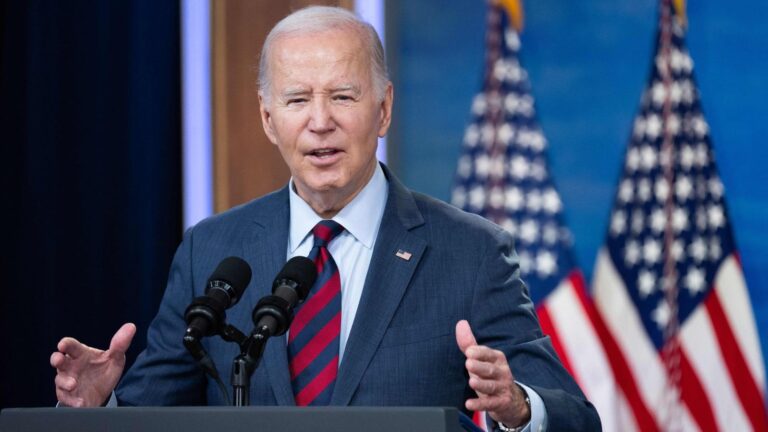US President Joe Biden delivers remarks in the South Court Auditorium of the White House in … [+]
The Biden administration this week released highly-anticipated data on a new initiative that makes it easier for borrowers experiencing hardships to discharge their student loans in bankruptcy.
The Education Department and the Department of Justice rolled out experimental guidance last fall to encourage cooperation between the government and student loan borrowers seeking bankruptcy relief. After a year, the program is showing clear signs of success.
“One year ago, we set out to simplify and improve the process for student loan borrowers in bankruptcy,” said Associate Attorney General Vanita Gupta in a statement on Thursday. “I am thrilled that our one-year review indicates that our efforts have made a real difference in borrowers’ lives by ensuring student-loan discharges are more accessible to eligible borrowers. We will continue working with our partners at the Department of Education to ensure the process continues to be a success.”
Here’s what borrowers should know.
Student Loan Forgiveness Through Bankruptcy
The current bankruptcy code makes it difficult (although not technically impossible) to discharge student loan debt. Student loans are treated differently from other forms of consumer debt in bankruptcy, like credit card bills or personal loans. To get a discharge in bankruptcy, borrowers must demonstrate that they have an “undue hardship” — a poorly-defined statutory term that has been interpreted by courts, which in turn have imposed rigorous tests to determine whether a borrower qualifies. In many jurisdictions, the undue hardship standard is exceptionally difficult to meet.
To demonstrate undue hardship, borrowers have to engage in an adversary proceeding, which is effectively a lawsuit initiated against their student loan lenders (including the government for federally owned student loans). While the borrower tries to show that they meet the undue hardship, the government and private student loan lenders wield enormous power and resources in opposition. This makes the adversary proceeding an unequal match in most cases.
Last fall, the Biden administration announced a partnership between the Education Department and Department of Justice to create policy guidance that makes it easier for federal student loan borrowers to request and obtain a student loan discharge in bankruptcy.
Under the guidance, borrowers seeking a student loan bankruptcy discharge would submit a financial attestation form thoroughly detailing the borrower’s overall circumstances and their hardships. Government officials would review this information, and ultimately make a determination as to whether the borrower meets the “undue hardship” standard under the bankruptcy code. If they do, then the Justice Department (which handles bankruptcy adversary proceedings involving federal student loans on behalf of the Department of Education) would not oppose a discharge in the adversary proceeding. With the parties in agreement, a bankruptcy court would — at least, in theory — be much more likely to approve a full or partial discharge of the borrower’s student loan debt.
New Data Suggests High Approval Rate For Student Loan Discharges In Bankruptcy
A year into the new initiative, the Education Department released data suggesting the new bankruptcy guidance is working.
“The vast majority of borrowers seeking discharge have received full or partial discharges,” according to the department. “In 99% of cases where courts have entered orders or judgments to date, the government recommended, and the court agreed to, a full discharge or partial discharge” of the borrower’s applicable federal student loan debt.
“It is clear that this improved process is helping struggling borrowers,” said Federal Student Aid Chief Operating Officer Rich Cordray in a statement on Thursday. “This guidance is an important piece of our overall efforts to create a student loan system that is more humane, with affordable payments and programs that work as intended. In partnership with the Justice Department, we will continue working to streamline this process and to provide student loan borrowers a pathway to obtaining much-needed relief in bankruptcy.”
Hurdles Remain For Student Loan Borrowers Seeking Student Loan Forgiveness Through Bankruptcy
While the data is promising for student loan borrowers, it also is incomplete, as it does not include student loan adversary proceedings that are still pending. It also does not expressly indicate how often the government is opposing undue hardship discharges under the new guidance.
Furthermore, the data also suggests that more work needs to be done to make borrowers and practitioners aware of the new policy. So far, “632 cases were filed in the first ten months of the new process (November 2022 through September 2023),” said the Education Department. This is an impressive number and represents “a significant increase from recent years,” says the department. Still, this is a tiny fraction of nearly 40 million federal student loan borrowers. Many — including bankruptcy attorneys — may not be fully aware of the new guidance. The administration indicates that it expects more cases to be filed in the coming months and years.
The Justice Department indicated that it is trying to get the word out about the new opportunity to seek student loan discharges in bankruptcy. The agency “has conducted large-scale trainings for Department attorneys, as well as public training events supported by regional bar associations and the courts, including most recently a training session hosted by the American Bankruptcy Institute that was attended by over 300 consumer bankruptcy attorneys,” according to Thursday’s statement. “The Department of Education also participated in training events hosted by regional bar associations, as well as at the annual meeting of the National Association of Chapter Thirteen Trustees (NACTT), which included private attorneys as well as Chapter 13 trustees.”
Further Student Loan Forgiveness Reading
These Student Loan Forgiveness Updates Will Impact 9 Million Borrowers Or More
Student Loan Forgiveness Could Happen If You Graduated In These Years
Didn’t Get A Student Loan Forgiveness Email? 7 Possible Reasons Why
2.9 Million Borrowers Will Not Have To Pay Their Student Loans Under New Biden Plan


